
Great Ellingham Parish Church of St James
St James is fundamentally a mid-14th century church. Kelly’s Directory of 1904, describes the church as “a spacious building of flint, with stone dressings, in an Early English style, consisting of chancel, nave of four bays, aisles, north porch and an embattled western tower with spire, containing 5 bells, re-hung in 1900”. There were said to be 500 sittings.
Some years later in 1925, Kelly’s Directory mentions “the church was refloored, re-seated, repaired and furnished in 1905 at a cost of £670; in 1924 the church was restored, when two frescoes, three consecration crosses, and a wall painting of a pilgrim with a staff over the shoulders, preaching cross, and part of an animal were discovered on the wall of the south aisle, a large medieval niche and a rood loft staircase were disclosed at the same time”.
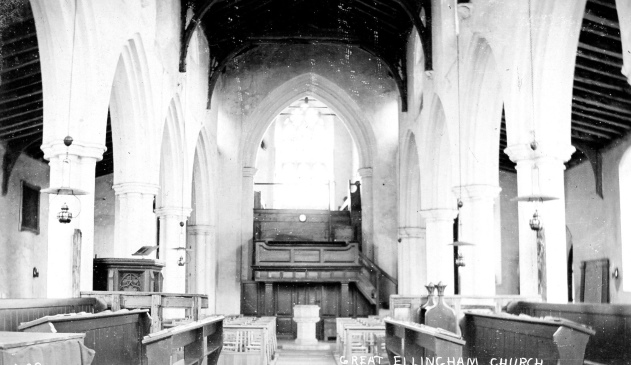
Interior of the Church of St James. Postcard courtesy of Christine Bell
Restoration Work
The Norwich Mercury of April 22nd, 1905 reported on the proposed restoration work at St James. The church was then said to have seating accommodation for 600 worshippers.
The Rector, the Reverend Polehampton (referred to in the article as the Rev. Poole Hampton) made an application at the Norwich Consistory Court on behalf of himself and the churchwardens for the power to carry out certain work at the church “which was greatly in need of repair”. The proposed work had been approved by the vestry at Great Ellingham.
The work included:
- the removal of the whole of the existing deal seats in the nave and in the aisle and replace the seats by chairs
- take up the existing floor and relay it on the existing level
- re-arrange the remains of the chancel screen so as to make an enclosure for the choir in the easternmost bay of the nave
- widen the altar
- remove the present vestry and make a new vestry under the tower
- repair the west door
It was also intended to replace the chancel screen on the spot where it was originally.
Although there was also a proposal to eventually repair the roof, walls, windows, tower and spire and to lay a new drain around the church, the Reverend Polehampton’s application at this stage was for a faculty for the initial work. The work for the present year would cost £650 of which the Reverend Polehampton confirmed that he had about £420 promised.
Completion of the Initial Work
Some eight months later, an article appeared in the Norwich Mercury of December 16th, 1905 concerning the completion of some of the restoration works at St James.
A service conducted by the Bishop of Norwich was held for the re-opening the church. It was said that the church had fell into a very bad state of repair but “since 1899 the Reverend E H Polehampton, Rector, has effected considerable improvement”.
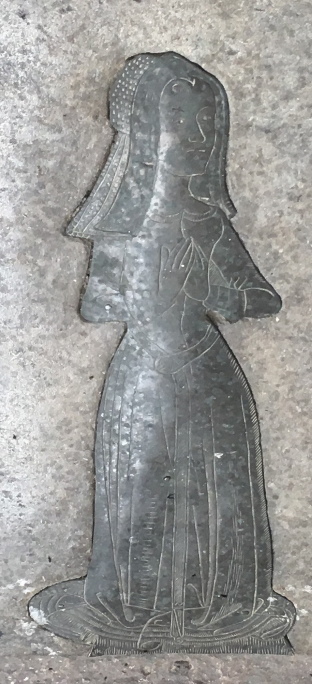

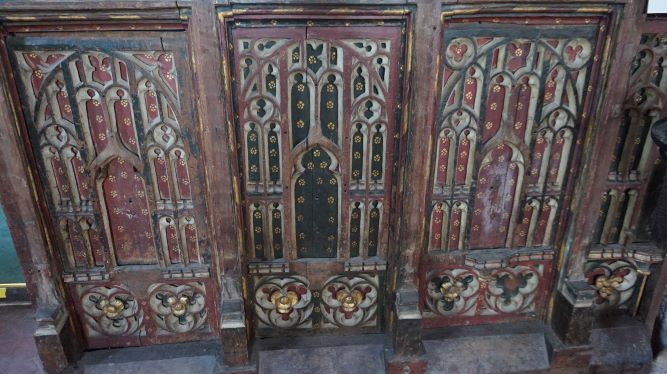
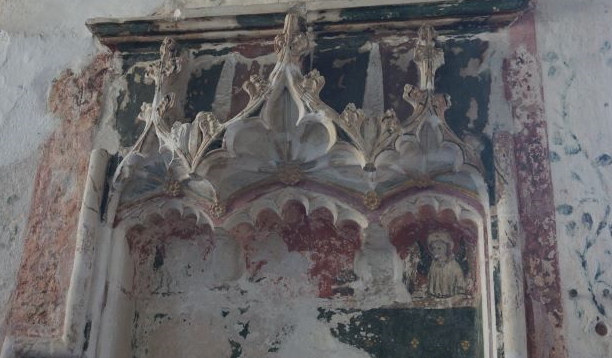
The Ancient Brass with parts of the old Rood Screen. Painted Plasterwork on the Walls of the Church
The work completed included:
- the floor had been re-laid with concrete tiles and wood blocks
- a new west door. Cladded oak on the outside and panelled and studded on the inside to “correspond with the ancient south door which has also been renovated”
- panelled roof to the vestry forming a ringer’s floor above
- the erection of the carved oak pulpit which had been presented to the church 15 years earlier
- the “old altar table in the Elizabethan style” had been renovated
- the choir stalls had been re-located to the first bay of the nave – their original position – and had been painted dark green to “harmonise with the colour scheme of the architect”
- the old high backed pews had been temporarily replaced with ‘ordinary church chairs’
- the old screen removed from the arch into the tower “allowing a splendid view of the beautiful west window”
- the minstrel gallery was re-decorated
- old peal of bells had been re-hung
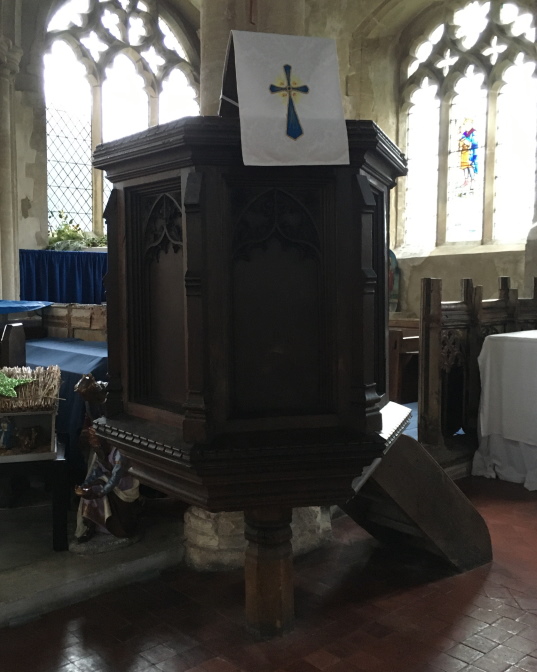

During the work, certain discoveries had been made:
- Many fragments of the old rood screen were discovered when the high backed pews had been pulled down
- An original altar stone was discovered which was re-set under the present altar table
- An original ancient brass figure of a female was found at the base of an old pulpit which has been re-laid in the floor of the sanctuary
It was also stated that a parsonage house had been built near the church, and a resident curate provided.
Mr J Arthur Reeve of Queen’s Gate, Westminster was named as the architect with the contractors being Messrs Hawes and Sons of Norwich.
‘A Bit of Scandal’?
In the invaluable book “A Little History of Great Ellingham” the author suggests that “a bit of scandal occurred in 1910-1912 when the church was furnished with chairs“. When the old box pews were removed and the floor raised about six inches, workmen unearthed many skeletons. It appears that the remains were muddled and were re-interred together in just one or two places.
A vault was also uncovered which contained a lead coffin. The exact place being where the reading desk stood in 1950.
Sources:
Lebbell W R & Fay S. “A Little History of Great Ellingham“
Kelly’s Directories 1904 & 1925. Attleborough Heritage Group, Attleborough Community & Enterprise Centre, Church Street, Attleborough NR17 2AH
Norwich Mercury December 16th, 1905
Norwich Mercury April 22nd, 1905